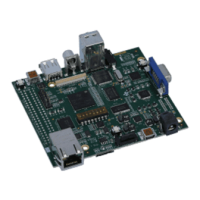Boot Loader
4. Wait for a single-byte acknowledgment from the device that it either properly received the data
or that it detected an error in the transmission.
The following steps must be performed to successfully receive a packet:
1. Wait for non-zero data to be returned from the device. This is important as the device may
send zero bytes between a sent and received data packet. The first non-zero byte received
will be the size of the packet that is being received.
2. Read the next byte which will be the checksum for the packet.
3. Read the data bytes from the device. There will be packet size - 2 bytes of data sent during
the data phase. For example, if the packet size was 3, then there is only 1 byte of data to be
received.
4. Calculate the checksum of the data bytes and ensure that it matches the checksum received
in the packet.
5. Send an acknowledge (ACK) or not-acknowledge (NAK) to the device to indicate the success-
ful or unsuccessful reception of the packet.
An acknowledge packet is sent whenever a packet is successfully received and verified by the boot
loader. A not-acknowledge packet is sent whenever a sent packet is detected to have an error,
usually as a result of a checksum error or just malformed data in the packet. This allows the sender
to re-transmit the previous packet.
The following commands are used by the custom protocol:
COMMAND_PING
= 0x20
This command is used to receive an acknowledge from the boot
loader indicating that communication has been established. This
command is a single byte.
The format of the command is as follows:
uint8_t pui8Command[1];
pui8Command[0] = COMMAND_PING;
April 8, 2013 9

